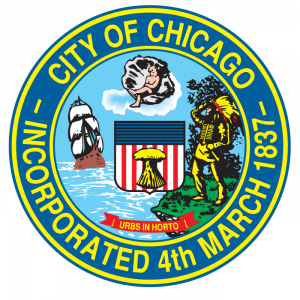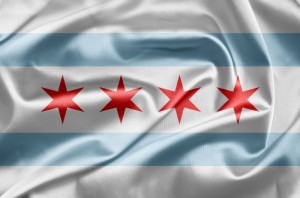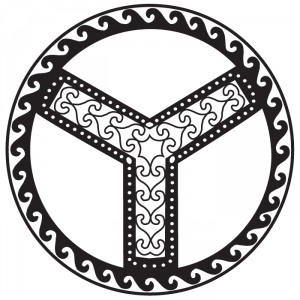Population: 2020 Census
- Chicago: 2,746,388
- Cook County: 5,275,541
- Illinois: 12,812,508
Geography
- Location: latitude, 41° 51´ N, longitude, 87° 39´ W
- Area (square miles): 228
- Lake front (miles of shore line): 28
- Altitude (feet above sea level in business district): 595
- Base line of street numbering system: State and Madison
Weather
Temperature
- Highest recorded temperature: 105° F, July 24, 1934
- Lowest recorded temperature: -27° F, January 20, 1985
- Most number of days in a year with temperature at 90° F: 47 days, 1988
- Longest continuous period below freezing (32° F): 43 days, 1976-77
Precipitation
- Most recorded precipitation in a month: 17.1 inches, August 1987
- Most recorded precipitation in a day: 6.86 inches, July 23, 2011
Snowfall
- Most recorded snowfall in a 24-hour period: 23 inches, January 26-27, 1967
- Most recorded snowfall in a season: 89.7 inches, winter 1978-79
Source
Symbols
Corporate Seal

When Chicago was incorporated as a city in 1837, a committee composed of Mayor William B. Ogden and Aldermen Josiah Goodhue and Daniel Pearsons was appointed to draft a new seal. The seal is described in the ordinance as "a shield (American) with a sheaf of wheat on its center; a ship in full sail on the right; a sleeping infant on the top; an Indian with bow and arrow on the left; and with the motto ‘Urbs in Horto’ at the bottom of the shield, with the inscription ‘City of Chicago-Incorporated, 4th of March, 1837’ around the outside edge of said seal." Amendments to the ordinance were made in June 1854 and February 1893, the first amendment specifying that "over the shield an infant reposes on a sea-shell," while the latter amplifies this by decreeing a "sleeping infant on top, lying on its back on a shell."
No drawings or reproductions of the original versions of the seal survived, so a new and corrected design and description was provided for by ordinance of March 20, 1905. This is the present seal of the City of Chicago. The shield represents the national spirit of Chicago. The Indian represents the discoverer of the site of Chicago. The ship in full sail is emblematic of the approach of civilization and commerce. The sheaf of wheat is typical of activity and plenty. The infant in the shell is the ancient and classical symbolism of the pearl, and Chicago, situated at the neck of the lake signifies that it shall be "the gem of the lakes." The motto "Urbs in Horto" means "City in a Garden." "March 4, 1837" in the seal is the date of the incorporation of the city.
Source
Flower

On June 17, 1966 the City Council adopted Mayor Richard J. Daley's resolution that the chrysanthemum be designated the official flower of the City of Chicago. Mayor Daley proposed the resolution in response to a request by the Committee on Beautification of Chicago.
Municipal Flag

Wallace Rice, a lecturer on heraldry and flag design at the Art Institute of Chicago, designed the original two-star flag that was adopted in 1917. City Council added two more stars, on October 9, 1933 and December 21, 1939.
The top white stripe represents the North side of the city. The center white stripe represents the West side of the city. The bottom white stripe represents the South side of the city.
The top blue stripe represents Lake Michigan and the North Branch of the Chicago River. The bottom blue stripe represents the South Branch of the Chicago River and the Great Canal.
Starting from the flagpole, the four red stars in the middle white stripe represent:
- Fort Dearborn, added in 1939. The points of the star signify the history of Illinois' governing bodies: France, 1693; England, 1693-1763; Virginia, 1763-1778; Northwest Territory, 1778-1798; Indiana Territory, 1798-1802; Illinois statehood, 1818.
- Great Chicago Fire of October 8-10, 1871, on the original flag. The points of the star signify transportation, labor, commerce, finance, populousness and salubrity (health).
- World’s Columbian Exposition of 1893, on the original flag. The points of the star signify religion, education, aesthetics, justice, beneficence and civic spirit.
- Century of Progress Exposition, added in 1933. The points of the star represent significant attributes of the city: world's third largest city (in 1933), Chicago’s motto "Urbs in Horto," the “I will" motto, Great Central Market, Wonder City, Convention City.
The meaning of the points is unofficial, and explanations vary from source to source. The official design is given in the Municipal Code.
Y SYMBOL

The Y symbol, also called the Municipal Device, represents the Chicago River and its two branches. The Y symbol is meant to be used unofficially by citizens, businesses and other organizations to promote pride in the city. Users are free to color and design it however they wish.
The most spectacular designs may be found in the Tiffany mosaics at the Chicago Cultural Center.

